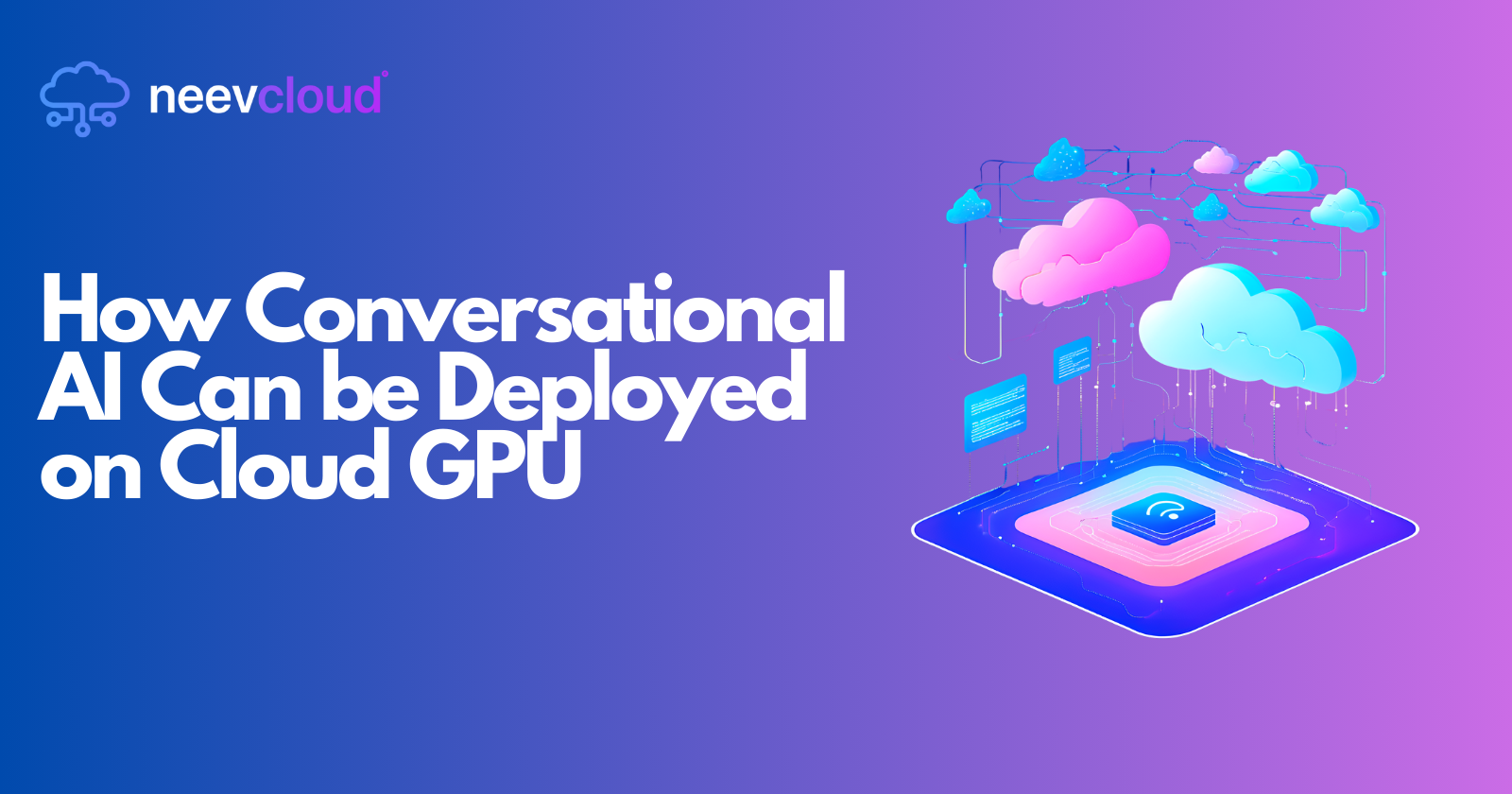How Conversational AI Can be Deployed on Cloud GPU
 Tanvi Ausare
Tanvi Ausare
In recent years, Conversational AI has emerged as a game-changing technology, revolutionizing how businesses interact with customers. From chatbots to virtual assistants, conversational AI enables more natural and intuitive interactions. However, deploying large-scale, high-performance conversational models can be resource-intensive. Enter Cloud GPU technology, which, combined with the latest advancements in GPUs like the Nvidia H100 and the upcoming H200, allows businesses to deploy scalable, efficient, and fast AI models on the cloud.
In this post, we’ll explore how Conversational AI can be efficiently deployed on Cloud GPU infrastructure, the benefits of using cutting-edge GPUs like the Nvidia H100 and H200, and the rise of the AI SuperCloud for delivering unprecedented performance.
What is Conversational AI?
Conversational AI refers to the use of machine learning and natural language processing (NLP) models to enable human-like interactions between computers and users. These systems can understand, process, and generate human language, making them useful for a variety of applications, including:
Customer support chatbots
Virtual assistants (e.g., Alexa, Siri, Google Assistant)
Automated content generation
Language translation
Interactive learning platforms
Key components of Conversational AI:
Natural Language Understanding (NLU): Allows machines to understand input text.
Natural Language Generation (NLG): Helps machines generate meaningful and contextual responses.
Dialogue Management: Handles the flow of conversation.
The Challenge of Conversational AI at Scale
Conversational AI models, particularly the large-scale ones such as GPT or BERT, demand significant computational resources for both training and inference. These models contain millions, if not billions, of parameters, requiring vast amounts of data and hardware to ensure low-latency, real-time responses. Traditionally, deploying such models on-premise has been both costly and challenging due to:
Hardware limitations: High-end GPUs and infrastructure are expensive and require constant maintenance.
Scalability: Scaling AI models across multiple devices or geographies can result in significant overhead.
Latency issues: Ensuring real-time performance, especially with global users, requires distributed computing, which on local infrastructure can result in bottlenecks.
Cloud GPU: The Key to Unlocking Scalable Conversational AI
Cloud GPUs provide a robust solution to the challenges of deploying conversational AI at scale. By leveraging the cloud, businesses can rent high-performance GPU instances for as long as they need without having to invest in physical hardware. This makes the deployment of conversational AI not only more scalable but also more cost-effective.
Key advantages of deploying Conversational AI on Cloud GPU include:
On-demand scalability: Cloud platforms allow you to scale resources up or down based on demand.
Global reach: By leveraging cloud data centers around the world, businesses can deploy AI models closer to end-users, reducing latency.
Cost-efficiency: Pay only for what you use, reducing the need for upfront investments in hardware.
High availability and reliability: Cloud providers offer redundancy and failover options to ensure uptime.
Why the Nvidia H100 and H200 GPUs are Game Changers for Conversational AI
Nvidia’s H100 and upcoming H200 GPUs are designed to handle the rigorous computational demands of AI workloads. These GPUs feature enhanced Tensor Cores optimized for AI, providing faster performance for model training and inference tasks.
Key features of the Nvidia H100 and H200 GPUs:
Enhanced Tensor Core technology: For faster AI model training and inference.
Larger memory bandwidth: To handle the enormous data throughput required by large-scale conversational AI models.
FP8 Precision Support: Allows for higher throughput during inference, improving performance without sacrificing accuracy.
Multi-instance GPU (MIG) support: Enables running multiple AI tasks simultaneously on a single GPU, optimizing resource utilization.
NVLink Interconnect: Ensures faster data transfer between GPUs for distributed training.
These capabilities make the Nvidia H100 and H200 GPUs perfect for deploying large-scale conversational AI models in the cloud.
Step-by-Step Guide to Deploying Conversational AI on a Cloud GPU
Let’s break down how you can deploy your Conversational AI model on a cloud GPU infrastructure using AI Cloud or AI SuperCloud platforms.
1. Define Your Use Case and Requirements
Determine whether your conversational AI model will be used for customer service, virtual assistants, or another application.
Decide on the expected traffic and the scale at which the model will be deployed. This will help you determine the size of GPU resources needed.
2. Choose the Right Cloud GPU Provider
Leading cloud platforms like AWS, Google Cloud, and Microsoft Azure offer Nvidia H100 GPU instances.
Explore AI SuperCloud platforms that are specifically optimized for AI workloads, offering better integration with machine learning frameworks like TensorFlow, PyTorch, etc.
NeevCloud provides AI-centric cloud solutions with GPU instances tailored for conversational AI deployments.
3. Select the Appropriate Conversational AI Framework
Leverage open-source frameworks like Hugging Face, Rasa, or Google Dialogflow to build your conversational AI models.
For deployment, tools like TensorFlow Serving or ONNX can optimize the models for cloud-based inference.
4. Set Up the Cloud GPU Environment
Use containerized solutions like Docker and Kubernetes to orchestrate scalable deployment.
Install the necessary AI libraries (TensorFlow, PyTorch, etc.) and optimize them for GPU acceleration.
Ensure that the environment is optimized for Nvidia H100 or H200 GPUs by leveraging CUDA and cuDNN libraries.
5. Train and Optimize Your Model
Transfer your training data to the cloud. Most cloud providers offer services like S3 (AWS) or Google Cloud Storage to store large datasets.
Train your model on Cloud GPUs by leveraging the massive compute power of Nvidia H100/H200 for faster convergence.
Use distributed training if needed, scaling across multiple GPUs to reduce training time.
6. Deploy and Scale Your Conversational AI Model
Use cloud-native orchestration tools like Kubernetes to manage the scaling of your deployed AI model.
Ensure real-time, low-latency responses by leveraging global Cloud GPU instances and distributing your model to edge locations closer to users.
Implement autoscaling to handle peak loads, ensuring seamless customer interactions without downtime.
7. Monitor and Optimize Performance
Use monitoring tools like Prometheus or Grafana to track the performance of your conversational AI models.
Monitor key metrics like latency, GPU utilization, and throughput to optimize the use of Cloud GPUs.
Continuously fine-tune your models to improve response accuracy and speed.
The Rise of AI SuperCloud for Conversational AI
As businesses increasingly adopt AI at scale, the concept of an AI SuperCloud has emerged. This refers to a highly optimized cloud infrastructure designed specifically for AI workloads. With AI SuperCloud, enterprises can leverage massive distributed GPU resources across various data centers to achieve performance that goes beyond traditional cloud computing.
Benefits of AI SuperCloud for Conversational AI:
Superior AI Optimization: AI SuperCloud platforms are pre-configured for AI and machine learning, reducing the need for manual optimization.
Seamless Integration: These platforms are tightly integrated with AI frameworks, offering easy deployment and management of large models.
Scalable Architecture: SuperCloud offers virtually unlimited compute resources, ensuring that conversational AI models can scale without performance degradation.
Faster Time to Market: AI SuperCloud reduces deployment times, allowing businesses to bring conversational AI applications to market faster.
Real-World Use Cases of Cloud GPU in Conversational AI
E-commerce Chatbots
- Major online retailers are using conversational AI deployed on Cloud GPUs to provide real-time customer support and personalized recommendations.
Healthcare Virtual Assistants
- Hospitals and telehealth providers use Nvidia H100-powered virtual assistants to manage patient inquiries and provide health information instantly.
Financial Services AI Advisors
- Financial institutions deploy conversational AI models on Cloud GPUs to assist customers in managing their accounts, investments, and financial planning.
Education Platforms
- Online learning platforms are leveraging conversational AI to create personalized learning assistants, powered by cloud GPU infrastructure for faster and more interactive learning experiences.
Conclusion
Deploying Conversational AI on Cloud GPUs opens up new possibilities for businesses seeking to scale AI-driven interactions without the burden of expensive infrastructure. By leveraging the power of Nvidia H100 and H200 GPUs, along with the evolving landscape of AI SuperCloud, businesses can achieve faster, more accurate, and scalable conversational AI systems. Whether you're building chatbots, virtual assistants, or more complex AI-driven applications, cloud GPU technology provides the flexibility and performance to make it all possible.
For businesses ready to embark on their AI journey, NeevCloud offers tailored solutions leveraging cloud GPU infrastructure, helping you deploy powerful conversational AI models with ease.
Subscribe to my newsletter
Read articles from Tanvi Ausare directly inside your inbox. Subscribe to the newsletter, and don't miss out.
Written by
